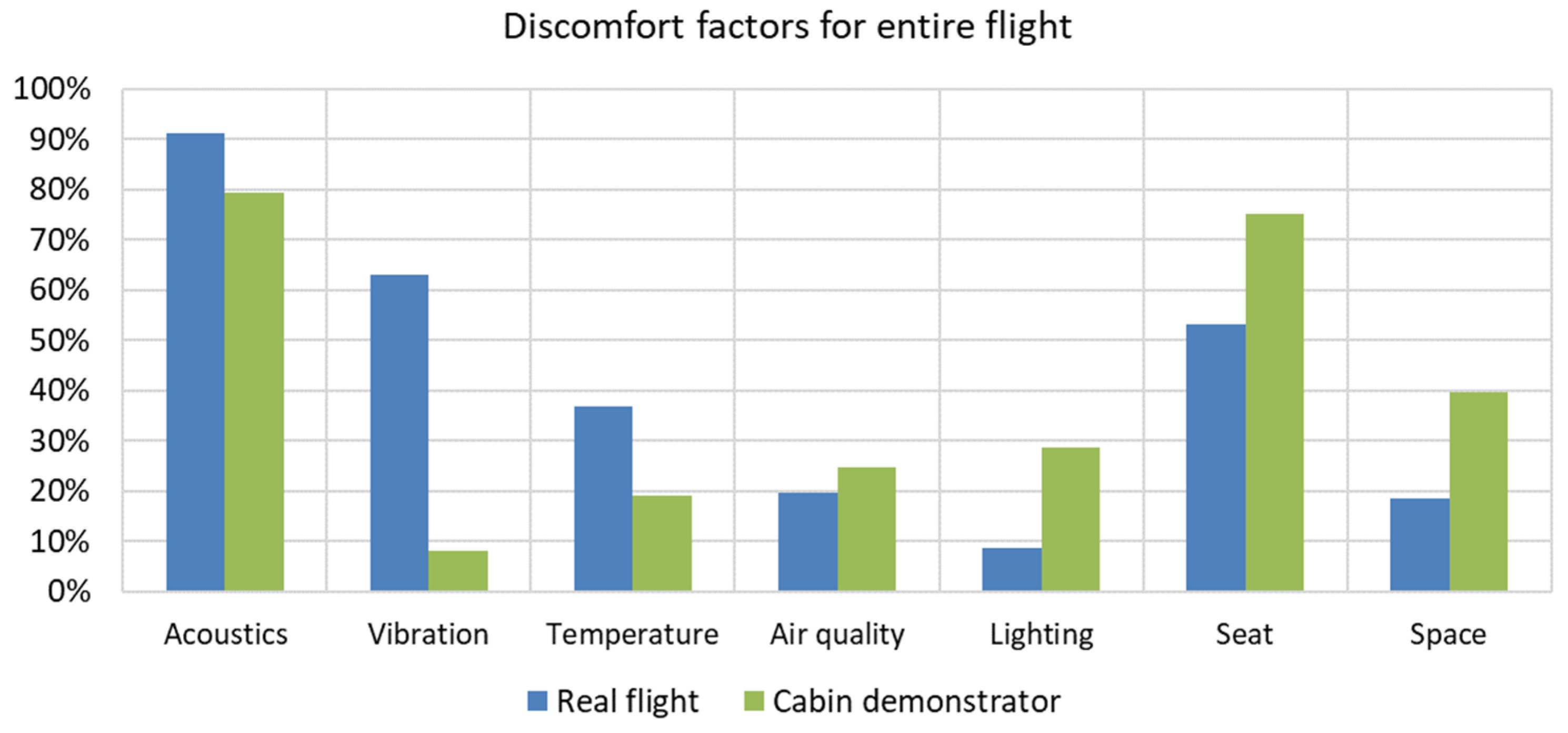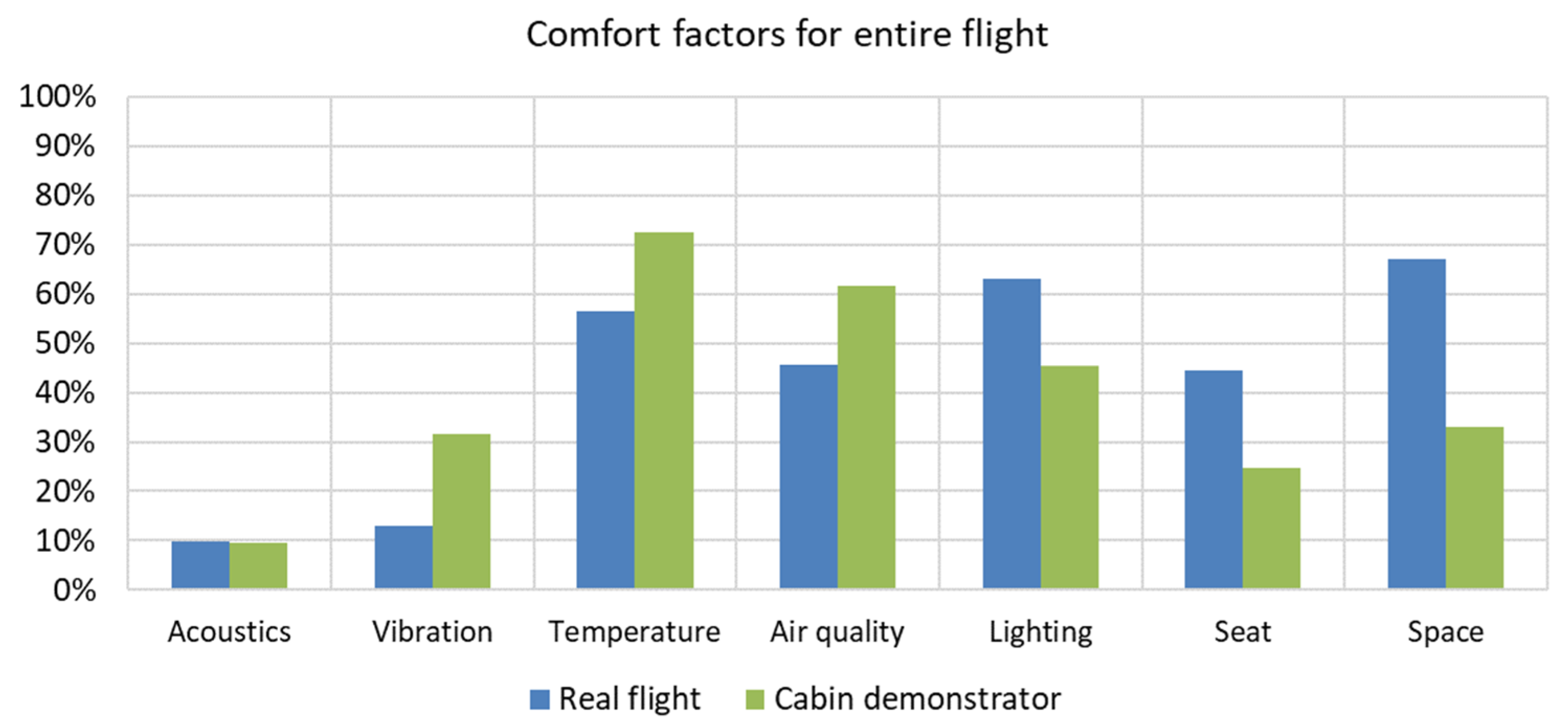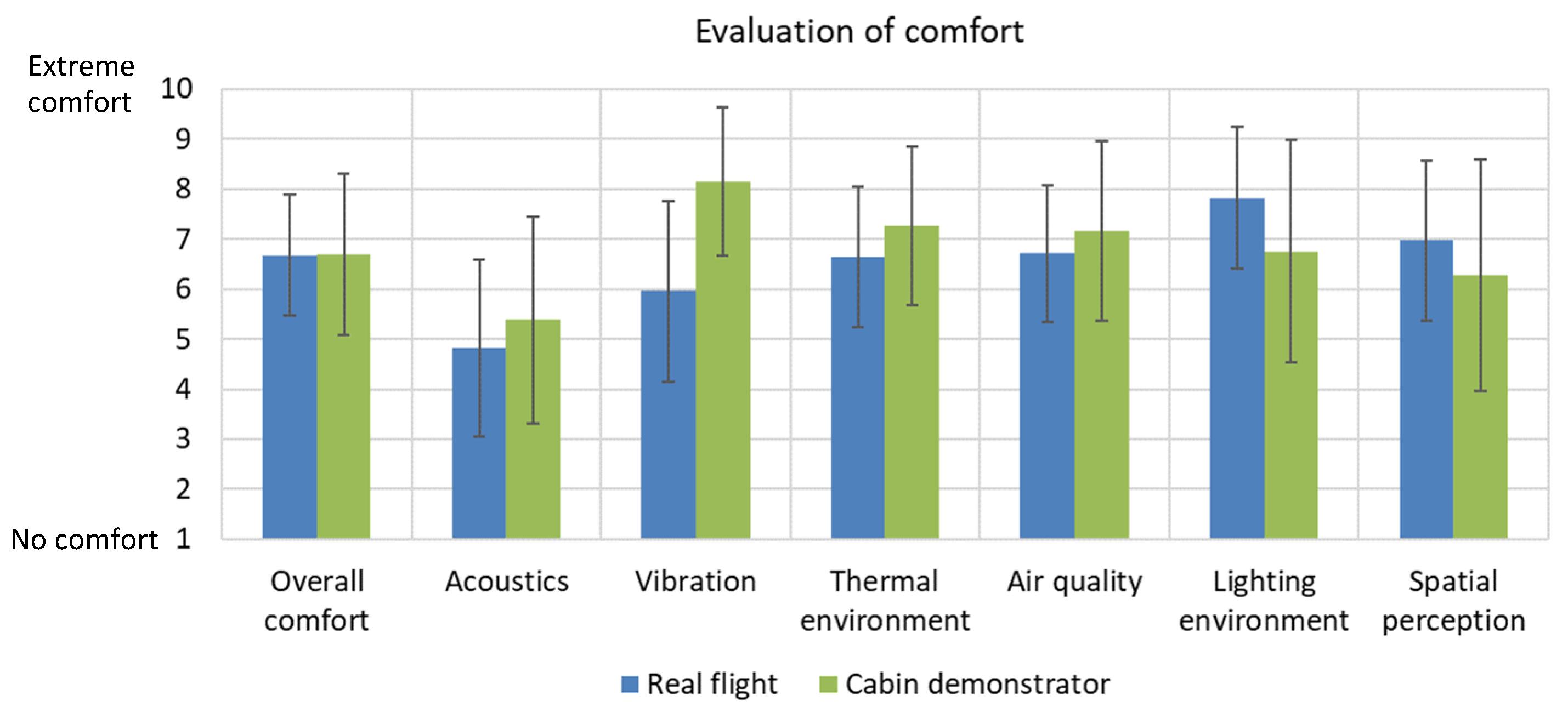Evaluation of an On-Ground Regional Passenger Cabin Demonstrator †
Abstract
:1. Introduction
2. Materials and Methods
2.1. Design and Procedure
2.2. Measures
- Acoustic environment;
- Air quality;
- Lighting environment;
- Thermal environment;
- Vibration;
- Overall comfort and discomfort.
2.3. Participants
3. Results
3.1. Sample Chararcteristics
3.2. Environmental Comfort
3.2.1. Acoustic Environment
3.2.2. Vibration
3.2.3. (Dis-)Comfort
4. Discussion
5. Conclusions
Author Contributions
Funding
Institutional Review Board Statement
Informed Consent Statement
Data Availability Statement
Acknowledgments
Conflicts of Interest
Appendix A
| Items | Flight Phase | Real Flights | Flights in Cabin Demonstrator | ||
|---|---|---|---|---|---|
| Mean (SD) | 95% CI | Mean (SD) | 95% CI | ||
| Perceived noise (1 = very loud, 7 = very quiet) | Ascent | 2.49 (0.93) | 2.30; 2.68 | 2.71 (0.83) | 2.52; 2.90 |
| Middle of cruise | 2.59 (1.05) | 2.38; 2.81 | 2.82 (0.75) | 2.65; 3.00 | |
| Descent | 2.85 (1.12) | 2.62; 3.08 | 3.04 (0.87) | 2.84; 3.24 | |
| Preferred noise (1 = much louder, 7 = much quieter) | Ascent | 5.65 (0.91) | 5.46; 5.83 | 5.34 (0.82) | 5.15; 5.53 |
| Middle of cruise | 5.72 (0.83) | 5.55; 5.89 | 5.32 (0.74) | 5.14; 5.49 | |
| Descent | 5.41 (0.89) | 5.23; 5.60 | 5.18 (0.70) | 5.02; 5.34 | |
| Annoyance (1 = not annoying, 4 = very annoying) | Ascent | 2.05 (0.69) | 1.91; 2.20 | 1.99 (0.79) | 1.80; 2.17 |
| Middle of cruise | 2.17 (0.72) | 2.02; 2.32 | 2.04 (0.98) | 1.81; 2.27 | |
| Descent | 2.06 (0.81) | 1.90; 2.23 | 2.01 (0.64) | 1.86; 2.16 | |
| Comfort (1 = no comfort, 10 = extreme comfort) | Ascent | 4.58 (2.08) | 4.15; 5.01 | 5.14 (2.07) | 4.65; 5.63 |
| Middle of cruise | 4.72 (2.00) | 4.31; 5.13 | 5.62 (2.34) | 5.07; 6.33 | |
| Descent | 5.22 (2.05) | 4.80; 5.63 | 5.79 (2.29) | 5.26; 6.33 | |
| Discomfort (1 = no discomfort, 10 = extreme discomfort) | Ascent | 5.10 (2.31) | 4.62; 5.58 | 4.89 (2.25) | 4.35; 5.42 |
| Middle of cruise | 4.66 (2.30) | 4.18; 5.13 | 4.84 (2.33) | 4.29; 5.15 | |
| Descent | 4.42 (2.23) | 3.96; 4.88 | 4.58 (2.36) | 4.01; 5.15 | |
| Acceptability (1 = very unacceptable, 7 = very acceptable) | Ascent | 4.46 (1.56) | 4.14; 4.78 | 4.55 (1.42) | 4.22; 4.88 |
| Middle of cruise | 4.45 (1.53) | 4.13; 4.76 | 4.60 (1.56) | 4.24; 4.97 | |
| Descent | 4.71 (1.49) | 4.40; 5.02 | 4.63 (1.42) | 4.30; 4.96 | |
| Pleasantness (1 = very unpleasant, 7 = very pleasant) | Ascent | 3.35 (1.22) | 3.10; 3.61 | 3.68 (1.18) | 3.41; 3.96 |
| Middle of cruise | 3.20 (1.16) | 2.96; 3.44 | 3.79 (1.39) | 3.47; 4.12 | |
| Descent | 3.59 (1.40) | 3.31; 3.87 | 3.90 (1.39) | 3.58; 4.23 | |
| Items | Flight Phase | Real Flights | Flights in Cabin Demonstrator | ||
|---|---|---|---|---|---|
| Mean (SD) | 95% CI | Mean (SD) | 95% CI | ||
| Perceived vibration (1 = no vibration, 5 = strong vibration) | Ascent | 2.62 (0.77) | 2.46; 2.78 | 1.93 (0.45) | 1.82; 2.04 |
| Middle of cruise | 2.49 (0.67) | 2.35; 2.63 | 2.00 (0.53) | 1.88; 2.12 | |
| Descent | 2.43 (0.73) | 2.28; 2.58 | 2.04 (0.58) | 1.91; 2.18 | |
| Sum vibration for body areas (11–55, higher values more vibration) | Ascent | 23.05 (6.35) | 21.69; 24.40 | 19.88 (4.69) | 18.56; 21.20 |
| Middle of cruise | 22.29 (5.92) | 21.04; 23.53 | 17.86 (4.13) | 16.76; 18.96 | |
| Descent | 21.63 (7.19) | 20.12; 23.14 | 18.36 (4.45) | 17.17; 19.55 | |
| Comfort (1 = no comfort, 10 = extreme comfort) | Ascent | 5.74 (2.10) | 5.31; 6.17 | 8.21 (1.66) | 7.82; 8.59 |
| Middle of cruise | 6.14 (1.92) | 5.74; 6.53 | 8.14 (1.82) | 7.71; 8.56 | |
| Descent | 6.03 (2.16) | 5.59; 6.47 | 8.14 (1.56) | 7.77; 8.50 | |
| Discomfort (1 = no discomfort, 10 = extreme discomfort) | Ascent | 3.81 (2.12) | 3.37; 4.25 | 2.25 (1.39) | 1.91; 2.58 |
| Middle of cruise | 3.36 (1.98) | 2.95; 3.77 | 2.49 (1.70) | 2.09; 2.90 | |
| Descent | 3.56 (2.14) | 3.12; 4.00 | 2.51 (1.60) | 2.12; 2.89 | |
| Acceptability (1 = very unacceptable, 7 = very acceptable) | Ascent | 5.33 (1.24) | 5.08; 5.58 | 5.99 (1.15) | 5.71; 6.25 |
| Middle of cruise | 5.36 (1.27) | 5.10; 5.62 | 5.96 (1.06) | 5.71; 6.21 | |
| Descent | 5.36 (1.37) | 5.08; 5.64 | 5.90 (1.02) | 5.66; 6.14 | |
| Pleasantness (1 = very unpleasant, 7 = very pleasant) | Ascent | 4.14 (1.36) | 3.86; 4.42 | 5.12 (1.34) | 4.81; 5.44 |
| Middle of cruise | 4.11 (1.27) | 3.85; 4.37 | 5.30 (1.27) | 5.00; 5.60 | |
| Descent | 4.22 (1.35) | 3.95; 4.50 | 5.21 (1.23) | 4.92; 5.50 | |
References
- Babikian, R.; Lukachko, S.P.; Waitz, I.A. The historical fuel efficiency characteristics of regional aircraft from technological, operational, and cost perspectives. J. Air Transp. Manag. 2002, 8, 389–400. [Google Scholar] [CrossRef]
- Kincaid, R.K.; Laba, K.E.; Padula, S.L. Quelling cabin noise in turboprop aircraft via active control. J. Comb. Optim. 1997, 1, 229–250. [Google Scholar] [CrossRef]
- Mansfield, N.; West, A.; Vanheusden, F.; Faulkner, S. Comfort in the regional aircraft cabin: Passenger priorities. In Proceedings of the 21st Congress of the International Ergonomics Association, Cham, Switzerland, 13–18 June 2021. [Google Scholar] [CrossRef]
- Vink, P.; Vledder, G.; Song, Y.; Herbig, B.; Reichherzer, A.S.; Mansfield, N. Aircraft interior and seat design: Priorities based on passengers’ opinions. Int. J. Aviat. Aeronaut. Aerosp. 2022, 9, 3. [Google Scholar] [CrossRef]
- Mellert, V.; Baumann, I.; Freese, N.; Weber, R. Impact of sound and vibration on health, travel comfort and performance of flight attendants and pilots. Aerosp. Sci. Technol. 2008, 12, 18–25. [Google Scholar] [CrossRef]
- Pennig, S.; Quehl, J.; Rolny, V. Effects of aircraft cabin noise on passenger comfort. Ergonomics 2012, 55, 1252–1265. [Google Scholar] [CrossRef] [PubMed]
- Richards, L.G.; Jacobson, I.D.; Kuhlthau, A.R. What the passenger contributes to passenger comfort. Appl. Ergon. 1978, 9, 137–142. [Google Scholar] [CrossRef] [PubMed]
- Montalvo, A.; Parra, P.; Polo, Ó.R.; Carrasco, A.; Da Silva, A.; Martínez, A.; Sánchez, S. Model-driven system-level validation and verification on the space software domain. Softw. Syst. Model. 2022, 21, 2367–2394. [Google Scholar] [CrossRef]
- Reichherzer, A.; Norrefeldt, N.; Herbig, B.; Müller, B.; Vink, P.; Song, Y.; Euhus, A.; May, A.; Bellmann, M.; Mansfield, N. Validation of a turboprop cabin demonstrator. J. Phys. Conf. Ser. 2024, 2716, 012027. [Google Scholar] [CrossRef]
- Müller, B.; Lindner, A.; Norrefeldt, V.; Song, Y.; Mansfield, N.; Vink, P. Measurement of noise and indoor climate on board a turboprop airplane flight. In Proceedings of the 33rd Congress of the International Council of the Aeronautical Sciences (ICAS 2022), Stockholm, Sweden, 4–9 September 2022. Available online: https://www.icas.org/ICAS_ARCHIVE/ICAS2022/data/preview/ICAS2022_0115.htm (accessed on 31 March 2025).
- Reichherzer, A.; Herbig, B.; Vink, P.; Song, Y.; Vledder, G.; Yao, X.; Mansfield, N.; Bellmann, M. Subjective evaluation of noise and vibration in a turboprop aircraft. In Proceedings of the Towards Sustainable Aviation Summit (TSAS) 2022, Toulouse, France, 18–20 October 2022. [Google Scholar]
- Ideal Cabin Environment (ICE). Health effects of airline cabin environments in simulated 8-hour flights. Aerosp. Med. Hum. Perform. 2017, 88, 651–656. [Google Scholar] [CrossRef] [PubMed]
- Veitch, J.A.; Charles, K.E.; Farley, K.M.J.; Newsham, G.R. A model of satisfaction with open-plan office conditions: COPE field findings. J. Environ. Psychol. 2007, 27, 177–189. [Google Scholar] [CrossRef]
- Newsham, G.R.; Veitch, J.A.; Charles, K.E. Risk factors for dissatisfaction with the indoor environment in open-plan offices: An analysis of COPE field study data. Indoor Air 2008, 18, 271–282. [Google Scholar] [CrossRef] [PubMed]
- ISO 28802:2012; Ergonomics of the Physical environment—Assessment of Environments by Means of an Environmental Survey Involving Physical Measurements of the Environment and Subjective Responses of People. International Organization for Standardization: Geneva, Switzerland, 2012.
- ISO 2631-1:1997; Mechanical Vibration and Shock—Evaluation of Human Exposure to Whole-Body Vibration. International Organization for Standardization: Geneva, Switzerland, 1997.
- Kremser, F.; Guenzkofer, F.; Sedlmeier, C.; Sabbah, O.; Bengler, K. Aircraft seating comfort: The influence of seat pitch on passengers’ well-being. Work 2012, 41, 4936–4942. [Google Scholar] [CrossRef] [PubMed]
- Veitch, J.; Farley, K.; Newsham, G. Environmental Satisfaction in Open-Plan Environments: 1. Scale Validation and Methods; National Research Council of Canada: Ottawa, ON, Canada, 2002. [CrossRef]
- McDowell, I. Measures of self-perceived well-being. J. Psychosom. Res. 2010, 69, 69–79. [Google Scholar] [CrossRef] [PubMed]
- Ramos, É.M.S.; Bergstad, C.J.; Nässén, J. Understanding daily car use: Driving habits, motives, attitudes, and norms across trip purposes. Transp. Res. Part F Traffic Psychol. Behav. 2020, 68, 306–315. [Google Scholar] [CrossRef]
- Beck, M.J.; Rose, J.M.; Merkert, R. Exploring perceived safety, privacy, and distrust on air travel choice in the context of differing passenger screening procedures. J. Travel Res. 2018, 57, 495–512. [Google Scholar] [CrossRef]





| Characteristics | Real Flights | Flights in Cabin Demonstrator | Differences |
|---|---|---|---|
| Age | 33.86 (±14.31) | 33.55 (±14.57) | t(165) = 0.16 |
| Gender | 58 men + 35 women + 1 other | 45 men + 27 women + 1 other | Chi2(1) = 0.01 |
| Weight [kg] | 73.0 (±13.2) | 74.3 (±10.7) | t(165) = −0.67 |
| Height [cm] | 176 (±10) | 178 (±8) | t(165) = −1.66 |
| Current health status 1 | 3.24 (±0.70) | 4.35 (±0.70) | t(156) = −0.09 |
| Flights per year | 7.10 (±10.00) (2019) | 4.66 (±5.00) (2023) | t(163) = 1.90 |
| Leisure flights [%] | 76.36 (±34.60) | 90.00 (±23.33) | t(161) = −2.88 ** |
| Business flights [%] | 13.02 (±27.04) | 7.60 (±20.18) | t(160) = 1.42 |
| Other flights [%] | 9.76 (±24.72) | 1.03 (±4.00) | t(160) = 2.99 ** |
| Flight duration | |||
| short < 2 h [%] | 32.25 (±37.18) | 17.50 (±26.90) | t(160) = 2.84 ** |
| medium 2–4 h [%] | 30.81 (±35.22) | 39.50 (±34.45) | t(160) = −1.57 |
| long > 4 h [%] | 35.80 (±37.03) | 39.40 (±36.40) | t(160) = −0.73 |
| Flight experience [1,2,3,4,5,6,7] | 5.70 (±1.26) | 5.53 (±1.52) | t(164) = 1.54 |
| Turboprop experience | Yes: N = 48 No: N = 29 Don’t know: N = 13 | Yes: N = 22 No: N = 47 Don’t know: N = 4 | Chi2(2) = 17.10 *** |
Disclaimer/Publisher’s Note: The statements, opinions and data contained in all publications are solely those of the individual author(s) and contributor(s) and not of MDPI and/or the editor(s). MDPI and/or the editor(s) disclaim responsibility for any injury to people or property resulting from any ideas, methods, instructions or products referred to in the content. |
© 2025 by the authors. Licensee MDPI, Basel, Switzerland. This article is an open access article distributed under the terms and conditions of the Creative Commons Attribution (CC BY) license (https://creativecommons.org/licenses/by/4.0/).
Share and Cite
Reichherzer, A.; Norrefeldt, V.; Müller, B.; Straninger, D.; Herbig, B.; Euhus, A.; Bellmann, M.; Vink, P.; Song, Y.; Mansfield, N. Evaluation of an On-Ground Regional Passenger Cabin Demonstrator. Eng. Proc. 2025, 90, 100. https://doi.org/10.3390/engproc2025090100
Reichherzer A, Norrefeldt V, Müller B, Straninger D, Herbig B, Euhus A, Bellmann M, Vink P, Song Y, Mansfield N. Evaluation of an On-Ground Regional Passenger Cabin Demonstrator. Engineering Proceedings. 2025; 90(1):100. https://doi.org/10.3390/engproc2025090100
Chicago/Turabian StyleReichherzer, Anna, Victor Norrefeldt, Benjamin Müller, Davide Straninger, Britta Herbig, Aenne Euhus, Michael Bellmann, Peter Vink, Yu Song, and Neil Mansfield. 2025. "Evaluation of an On-Ground Regional Passenger Cabin Demonstrator" Engineering Proceedings 90, no. 1: 100. https://doi.org/10.3390/engproc2025090100
APA StyleReichherzer, A., Norrefeldt, V., Müller, B., Straninger, D., Herbig, B., Euhus, A., Bellmann, M., Vink, P., Song, Y., & Mansfield, N. (2025). Evaluation of an On-Ground Regional Passenger Cabin Demonstrator. Engineering Proceedings, 90(1), 100. https://doi.org/10.3390/engproc2025090100






